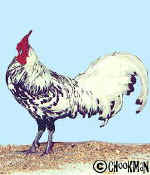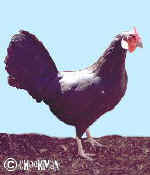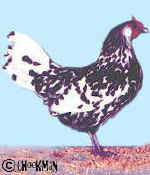The Hamburgh is one of the oldest known European
breeds.
It would appear that along with the Dorking and Old
English Game, they were established in Britain at the time of the Roman invasions of the
4th century AD. The early naturalist, Aldrovandus described a chicken in the 14th century
in Italy which by his description had to be a Hamburgh. No other breed has the distinctive
rose comb which shape has been described as "a wisp of flame".
In Yorkshire and Lancashire they were known as
Pheasants and Moonies. Eventually, these two breeds were crossed and became what is now
known as the spangled Hamburghs. Birds were carried to the local inns and exhibited
against each other, the onlookers being the judges. Thus, as far back as the 1700's the
Hamburgh was bred to a high state of perfection, possibly no other breed of chicken has
ever been so judiciously developed.
The pencilled varieties have a different ancestry,
being more like the north European chickens such as Campines and Frieslands. The pencilled
varieties were known as Dutch Everyday Layers..... the name says it all!
Hamburghs have been used in the development of many
of todays modern chickens. Wyandottes, Sebrights and virtually every rose combed breed or
variety has Hamburgh blood in its make up.
The distinctive features of the Hamburgh are the
comb, round white lobes, soft flowing feather and beautiful markings. Originally Hamburghs
came in five colours, these being Black, Gold Spangled, Silver Spangled, Gold Pencilled
and Silver Pencilled. In the USA, whites and blues are also standard and there are records
also of buffs and silver laced blacks. All colours are standardised in bantams except
white and black.
Why Hamburghs have the name they do is a mystery, as
they appear to have no correlation with the German port of Hamburgh from which the name
originates.
|

A silver spangled male

A beautiful black hen

A silver spangled bantam pullet
How
to breed Gold Pencilled Hamburghs |